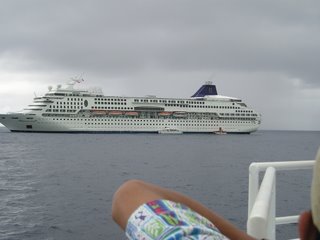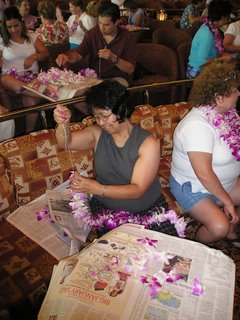
This is a picture that I took of the Norwegian Wind from a Tender. We were on our way back to the ship from one of the ports.
The Wind was built in 1993 and then enlarged in 1998. They actually split the ship in half and added a new section in between the two halves. On board, I saw before and after pictures of this.
The Wind is about 51,000 tons which is about half of the size of newer cruise ships. This was the second cruise for my wife and I, both aboard the same ship. We were on the Norwegian Wind in 2003. On that cruise we visited Alaska. I will write about that trip sometime in the future.
We did not plan to go on the same ship. We wanted to visit Hawaii, and our travel agent (www.cruise-connections.com) found us a very good deal for a 10 day cruise on the Wind. I was surprised when he told us the name of the ship.
The itinerary was to leave Honolulu on Wednesday, stay in Hilo on Thursday, spend two days at sea, visit Fanning Island in the Republic of Kiribati on Sunday, spend two days at sea, stay in Nawiliwili on Wednesday, Thursday visit Lahaina and then stop in Kona on Friday before returning to Honolulu on Saturday. As a result of a small problem, the captain had to change our itinerary in route. I will explain that in a future posting.
My wife and I liked the ship. We heard some other guests complain about some things. My suggestion is that if you are going to spend the money for a cruise, take the time to investigate the itinerary, the cruise line and the ship. Be informed.
Some guests did not like the four days at sea. I do not understand why they booked this cruise. There are other cruises in Hawaii that do not visit Fanning Island. (I will explain why the Norwegian Wind did in another post.)
Some guests complained about the "Freestyle Cruising." This is how Norwegian Cruise Lines describes their style of organizing service on board. There are differences between Cruise Lines and how they service their guests. You should understand this before you book.
Other guests thought that the ship was too small. Why did they book a cruise on a smaller ship if they wanted the features of a big ship?
Complaining about these things proves that a person was unwise in their choice of a vacation package. It is a reflection on the individual not the cruise. It also makes it harder for them and those who hear their useless complaints to enjoy their vacation.






















